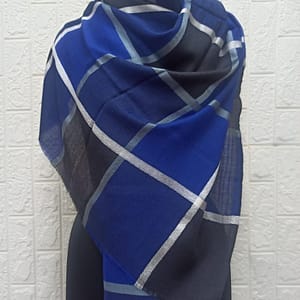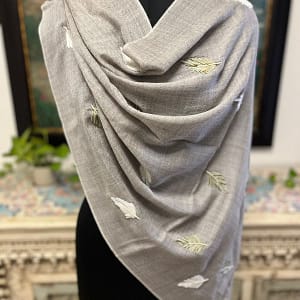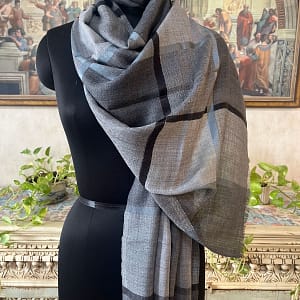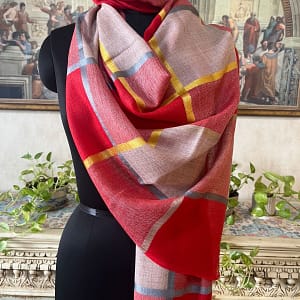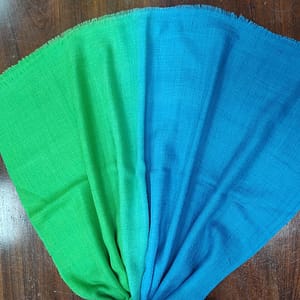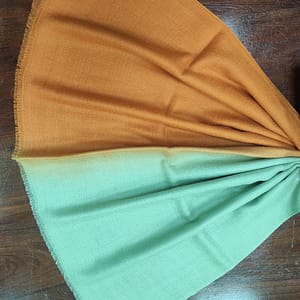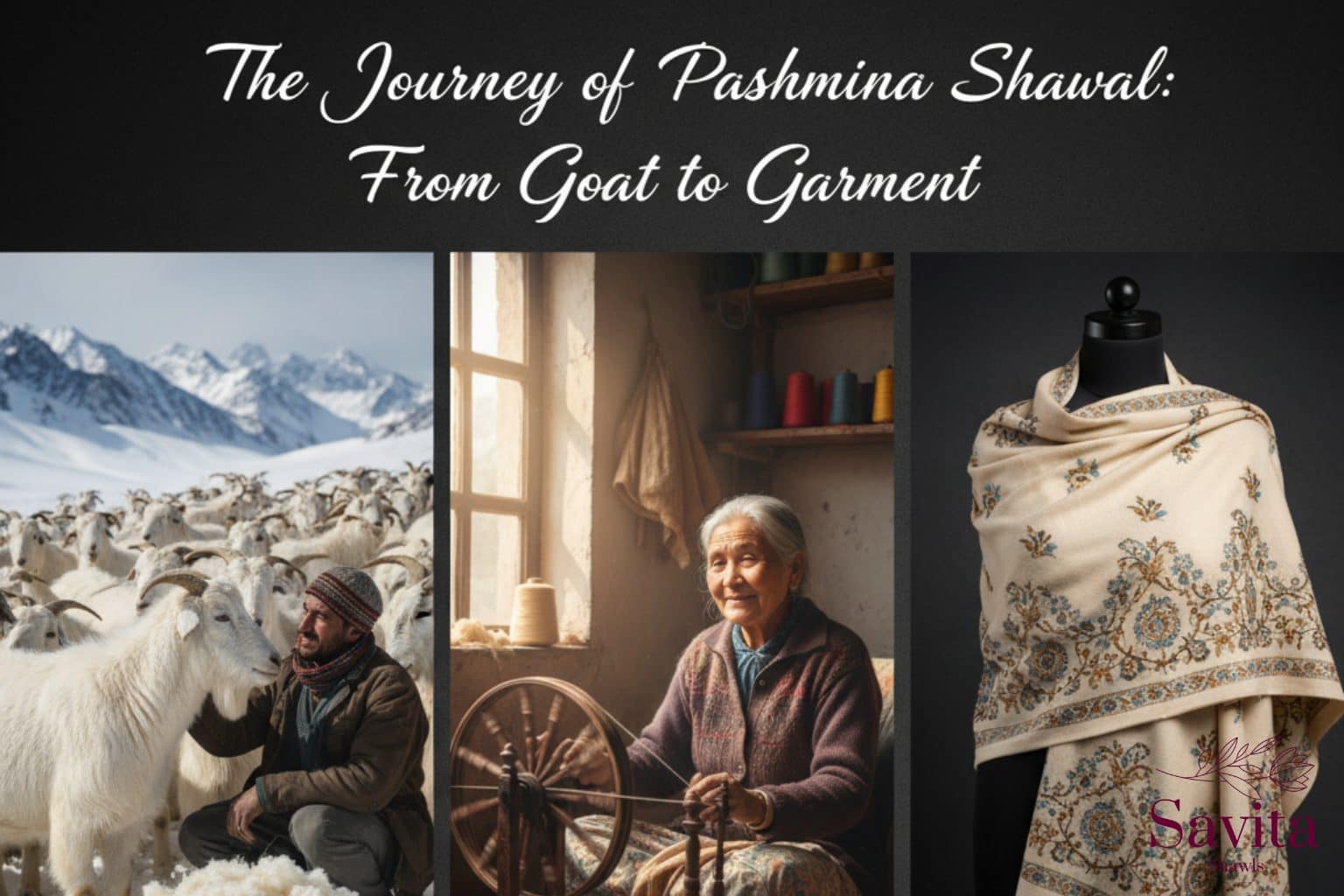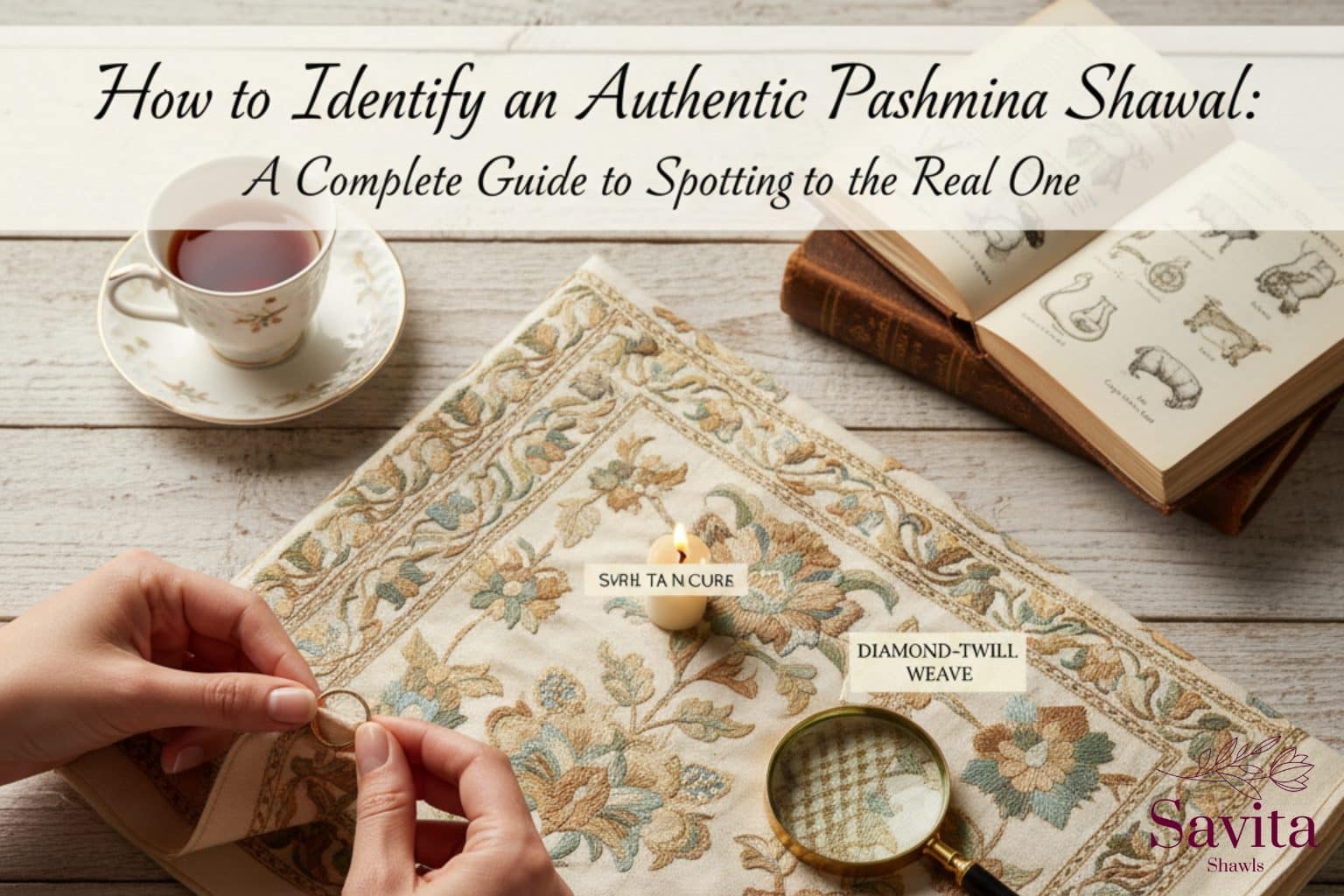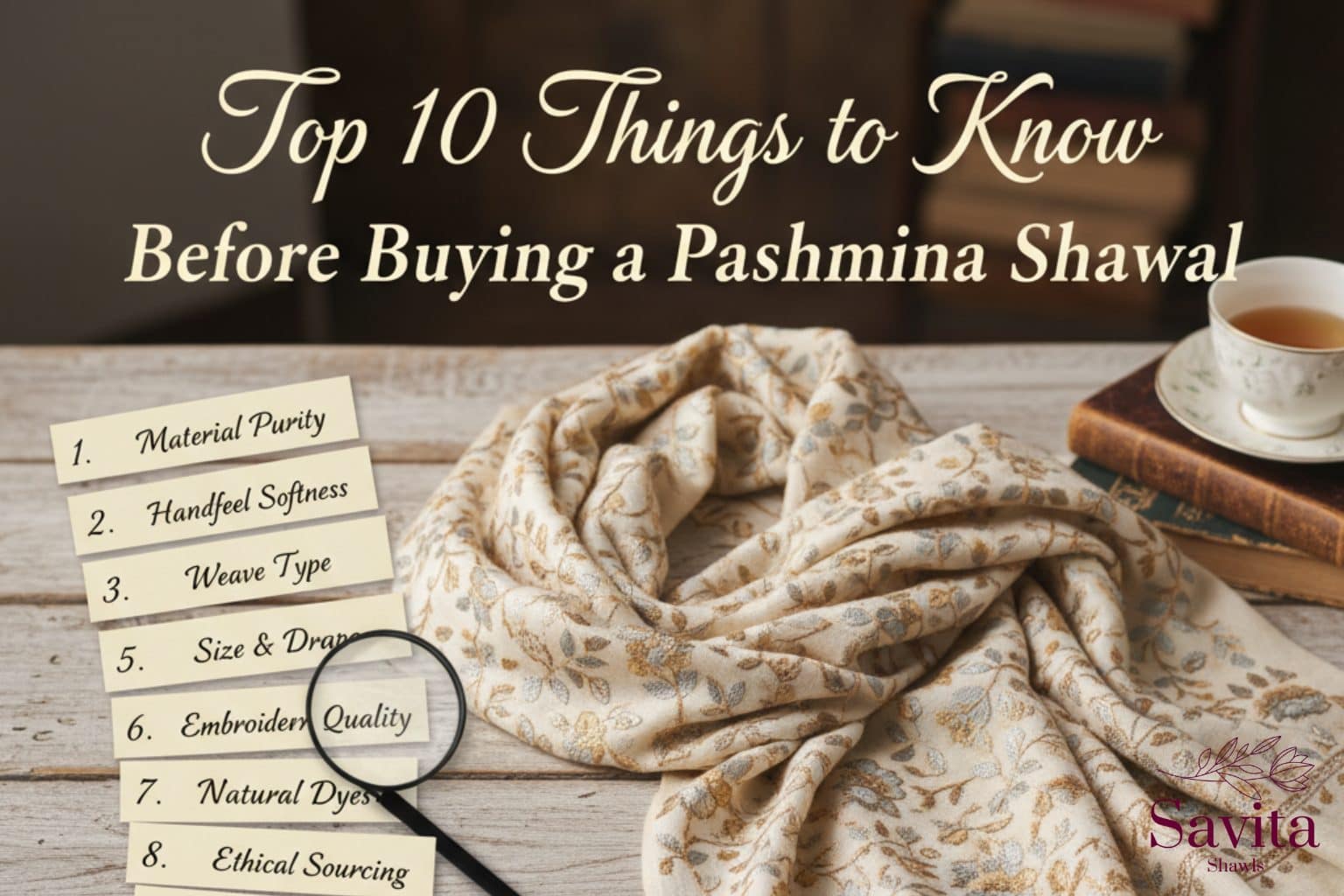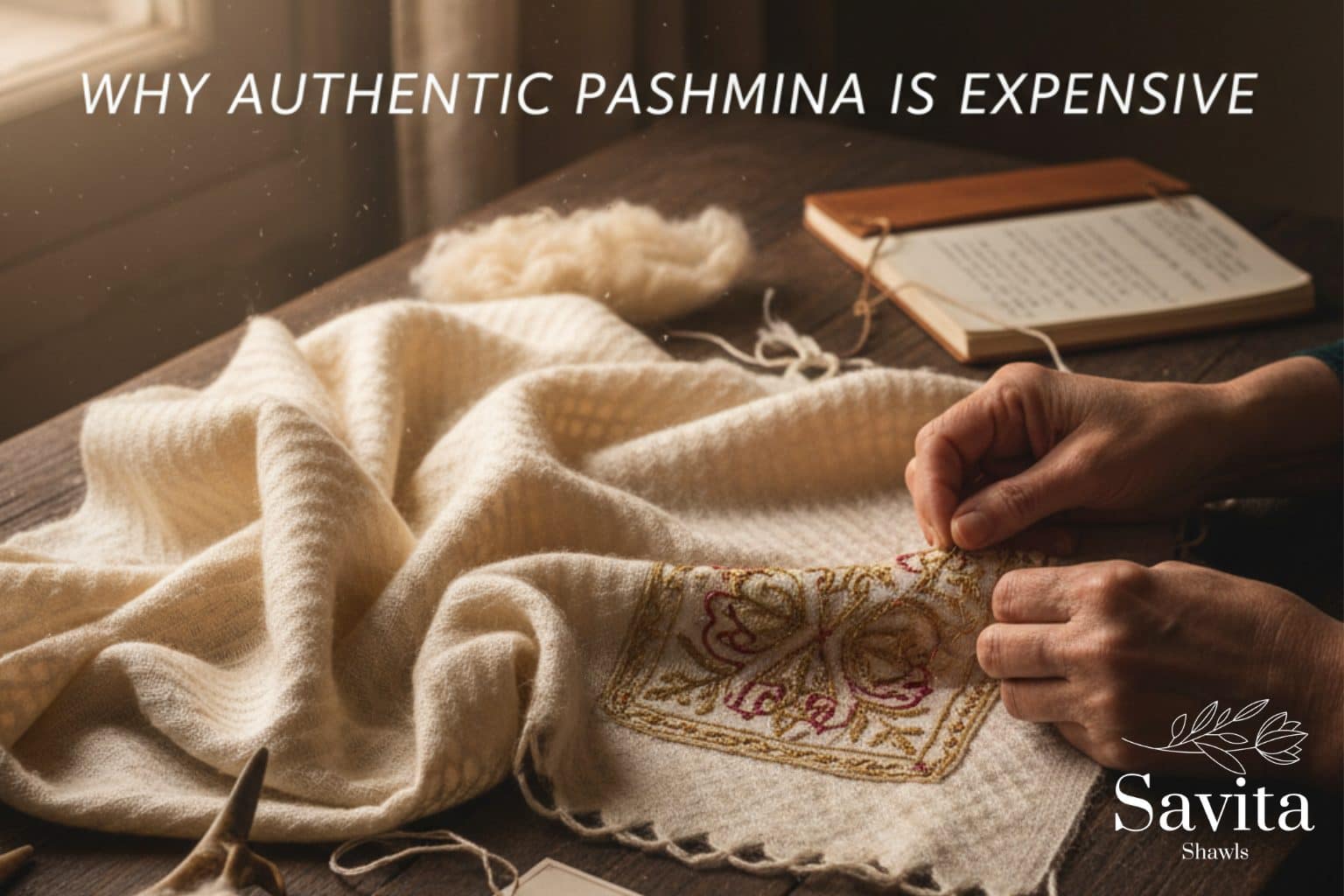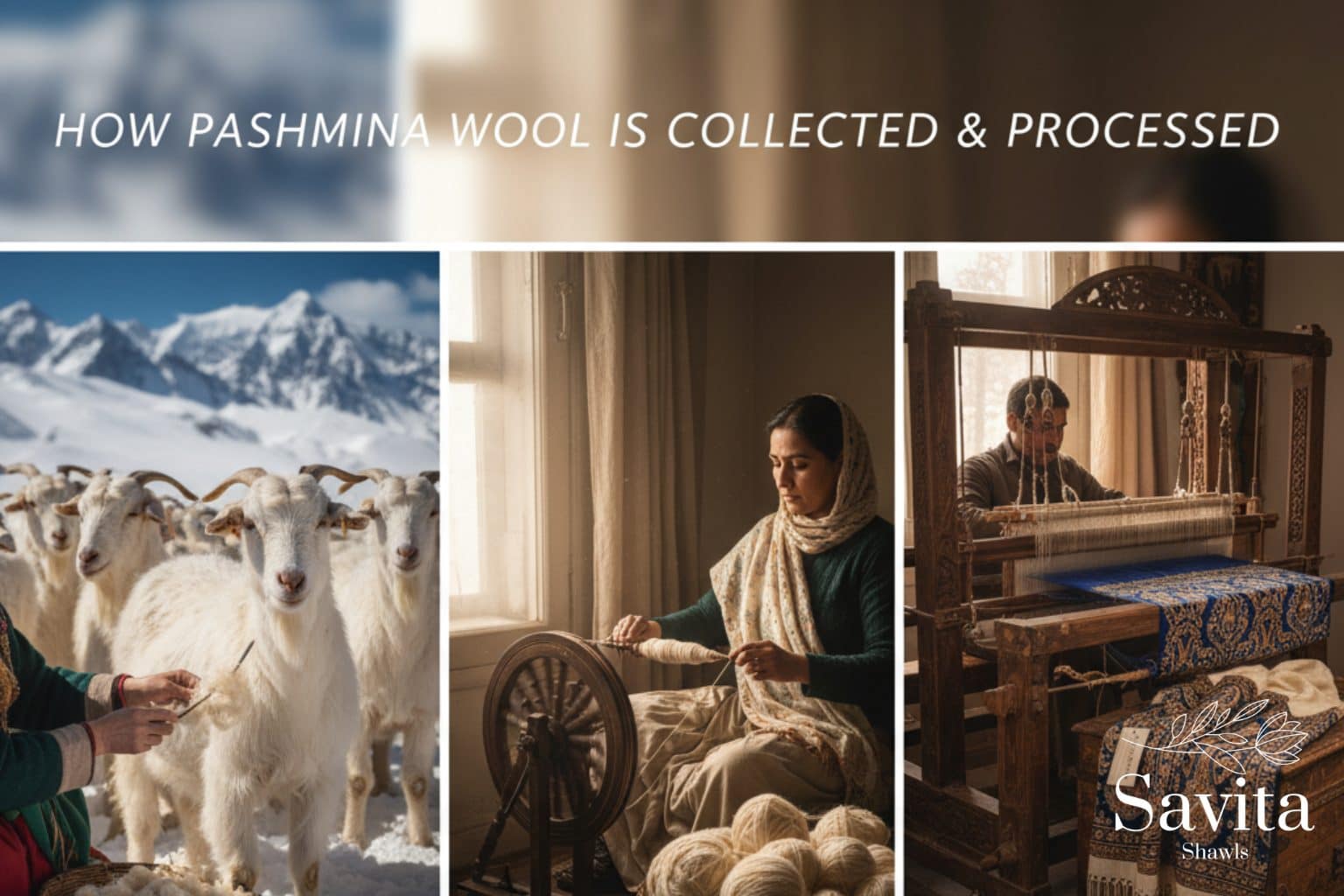Introduction – The Real Story Behind Why Pashmina Is Expensive
As soon as a person touches a real Pashmina shawl for the very first time, the person’s response is always one of wonder. The incredible softness of the material, its heat-retaining property, and its nearly weightless quality all at once suggest that the wearer is surrounded by the luxury and comfort. However, this question naturally arises — what is the reason for Pashmina being so costly in comparison with the other types of wool, cashmere, or blended ones that are sold in the market?
At Savita Shawls, the Pashmina manufacturer that is most trusted in Delhi, India, we are of the opinion that the/explanation for the high price of Pashmina goes hand in hand with the fabric itself — it is all about the heritage, craftsmanship and authenticity. Every authentic Pashmina item is imbued with the soul of the centuries-old art, which is why it is much more expensive than ordinary wool or synthetic versions.
1. The Rarity of the Raw Material
The first and foremost reason why Pashmina is expensive lies in its origin. The fiber used for genuine Pashmina comes from the undercoat of the Changthangi goat, which is a very rare breed and lives only in the very high and cold regions of the Himalayas in Ladakh. The goats have to endure the harshest of winters, and eventually, they yield ultra-fine and delicate hair that is painstakingly gathered by hand. The limited availability of this wool has a direct effect on the price of Pashmina, as the supply is naturally restricted while global demand for the product is still soaring.
2. The Labour-Intensive Craftsmanship
The detailed and labor-heavy craftsmanship that takes place is the other big factor that characterizes the price of the genuine Pashmina. A single Pashmina shawl goes through the hand-spinning, hand-weaving, and hand-finishing of the master artisans who have their art passed down from their ancestors. Each genuine Pashmina goes through a series of delicate manual steps—the spinning, weaving, dyeing, and finishing—all of which add to its value as Pashmina.
3. The Unmatched Softness and Warmth
The premium quality of the real Pashmina fibers is the foundation for the fabric to possess the amazing softness and lightness of warmth. It is an extremely thin fabric, yet it is the best at insulation in that it makes the wearer feel warm comfortably without the weight. This deluxe comfort is an important factor in the reason why Pashmina is expensive, since the very qualities of it cannot be reproduced by synthetic or machine-processed materials.
4. The Symbol of Luxury and Heritage
The real Pashmina has never failed to be a symbol to the world of luxury and pride in culture. For ages, kings and queens, the upper class, and luxury seekers have valued Pashmina shawls for their rarity and timeless beauty. Nowadays, wearing a Savita Shawls Pashmina is not just about putting on a piece of clothing — it’s about having the opportunity to live a heritage. This emotional and historical connection is also a factor in the Pashmina value and helps to clarify why Pashmina is expensive in the global fashion market.
5. Authenticity and Quality Assurance
The market has been inundated with counterfeit products due to Pashmina’s allure, yet the real Pashmina remains unreplaceable. The price of the real Pashmina involves, besides the rarest fiber and skilled workers, strict quality controls to ensure the product’s purity. Every shawl from Savita Shawls is subject to a thorough examination to keep its originality, quality, and traditional spirit — giving the customers a guarantee of getting true value for their money.
To sum up, Pashmina is not expensive only because of its Pashmina price tag; it is about all that is involved in the making of it — the rarest Himalayan wool, the most intricate artistry, and the longest-lasting legacy. The Pashmina shawl is, therefore, a symbol of dedication, tradition, and refinement. Your purchase of an authentic Pashmina from Savita Shawls is not merely an acquisition of a product; it is a welcoming of a centuries-old art form and a preservation of the real Pashmina worth that characterizes luxury.
The Origin – Rare Wool from the Himalayas
The very first reason why Pashmina is expensive lies in its rare and pure origin. The true Pashmina wool comes from Changthangi goats, which are widely known as Pashmina goats. These goats live in the freezing cold, high-altitude areas of Ladakh and the northern part of India, the Himalayas. They stay at a height of 14,000 feet above sea level where the temperature is very low. To cope with the severe weather, the goats produce an ultra-fine undercoat which is the raw material for the genuine Pashmina.
Delicate Fibers of Extraordinary Fineness
What makes this wool so special and why Pashmina is expensive? The answer lies in the fineness of its fibers. Each pure Pashmina strand has a diameter of only about 12 to 15 microns, which is significantly thinner than a human hair. The fabric’s unique structure is responsible for its superior softness, warmth, and lightness. The smoother the fiber, the more luxurious and comfortable the shawl feels. This microscopic delicacy is among the primary reasons for the high Pashmina price and is also the reason why its possession is sought after by the experts from all over the world.
Limited Yield Adds to Its Authentic Pashmina Cost
In contrast to ordinary sheep which produce large quantities of wool every year, a single Changthangi goat yields only 80 to 150 grams of usable Pashmina wool annually. Of the total, a small portion is suitable for fine yarn spinning. This yield is so minimal that it results in a limited production of Pashmina and hence the cost of authentic Pashmina is automatically increased. Once you get to know how little raw material is there from each goat, the high price and scarcity of Pashmina become evident.
A Seasonal and Sustainable Collection Process
The Pashmina wool collection takes place once a year in spring and is done under very specific conditions—that is, during the process of shedding the animals’ inner coat. The herders who are skilled in this art do not use the common method of shearing but rather delicately comb the wool by hand, so that no injury to the animals occurs. This slow, ethical and sustainable method not only ensures purity and the Pashmina value of the fiber but also increases the time and cost of the labor involved in its preparation.
Geographical Exclusivity and Climatic Rarity
The extreme nature of the Ladakh and upper Himalayas cannot be replicated anywhere else in the world. The climate, high location and other factors combined lead to the production of delicate fibers of the high quality that they cannot be duplicated even with artificial methods. This geographical limitation is one more compelling factor that makes Pashmina very expensive and continues to associate it with authenticity and luxury. The Pashmina price amounts not only to the product but to the gift of nature, which is created in one of the planet’s most inhospitable and yet beautiful regions.
In conclusion, the reasons for the high cost of Pashmina are the very origin — the rarity of the Changthangi goat, the quality of the fiber, the low production and the animal-friendly collection. All these factors combined lift the price of authentic Pashmina and determine the true Pashmina value. Each real Pashmina shawl from Savita Shawls is a natural plus cultural masterpiece, a timeless work that represents the Himalayas’ purity and perfection.
The Labor-Intensive Collection and Cleaning Process
The tireless and completely manual work that turns raw goat hair into a piece of luxury has a huge impact on the price of the Pashmina. The fibers are very soft and are collected from the Changthangi goats, they have a long and complicated process for cleaning and dehairing. No machinery is used, as the extremely fine Pashmina fibers may easily break or lose their softness if they are not properly handled. Every single Pashmina wool is handled like a precious gem since its purity and texture are the main determinants of both Pashmina value and authentic Pashmina cost.
A Purely Manual and Ethical Process
The process starts in spring when, during this period, the raw wool is the finest and the goats are combed very gently. The wool is rich in natural oils, dust, and coarse outer hair that has to be removed by hand. Skillful artisans, who are mostly women from Himalayan villages, do this painstakingly meticulous task. Each procedure—from using cold mountain water for washing the wool to separating the coarse fibers by sun-drying—demands extreme patience and accuracy. This manual, time-consuming process is a significant factor in understanding why Pashmina is so pricey and why the market value of every authentic Pashmina product is relatively high.
No Machines — Only Traditional Expertise
Authentic Pashmina, unlike ordinary cashmere or machine-made shawls, cannot at all be produced by industrial machines. The fibers are so fine and delicate that they cannot stand the treatment of modern machinery. Therefore, the artisans have to rely on their hands and traditional tools completely. Wool is spun on a “charkha” (spinning wheel) by hand — a method that takes years of training and sustained concentration. Depending on the texture and the size of the shawl, it might take several days, sometimes even weeks, to produce enough yarn for one piece. This commitment to hand-spinning escalates the labor costs and provides one more reason why Pashmina is pricier than synthetics or machine-woven fabrics.
Empowering Himalayan Artisans
Moreover, the traditional Pashmina process not only supports the income of thousands of Himalayan women but it also allows them to pass on this delicate art from one generation to another. The supreme quality of the skill guarantees that every Pashmina keeps its genuineness, fluffiness, and heat. At the same time, the artisans’ hard work and know-how are the main factors that determine the authentic Pashmina’s price. Getting genuine Pashmina means you are not just paying the price for Pashmina — Besides, you are actually promoting a cultural heritage and a community of skilled craftswomen who have been and are still committed to this ancient tradition by expressing it through their talents.
Preserving Authenticity and Pashmina Value
The fiber’s integrity and Pashmina’s value being unmatched are two things that every step of the collection and cleaning process aims to achieve. Although machine-made shawls are more affordable, they can never be able to re-create the natural softness, warmth, and character of authentic, hand-processed Pashmina. The detail in washing, sorting, and spinning is what distinguishes true Himalayan Pashmina from its imitations, and this devotion to purity is one of the main reasons why Pashmina is so expensive and, at the same time, so valued everywhere.
To sum up, the labor-intensive process of real Pashmina sets the bar for its exclusivity. The careful collection of fibers to the skilled spinning on traditional wheels, each step is a contributing factor to its Pashmina value and authenticity. Patience, artistry, and human touch are the qualities that are involved in each shawl, and that is why Pashmina is expensive. Thus, every creation from Savita Shawls is not only a product but also a legacy of Himalayan craftsmanship and cultural pride.
Traditional Hand Weaving on Wooden Looms
The weaving process is when the artist’s skill brings the Pashmina yarn to life gently and subtly. This is one of the major reasons for the high price of Pashmina and its worldwide admiration. Each real Pashmina shawl is being made entirely by hand using traditional wooden looms that have been passed down from one generation of Himalayan craftsmen to another. Such an age-old method makes sure that every single piece has the characteristics of precision, patience, and passion — which machines can never offer.
A Generational Craft That Defines Pashmina Value
In contrast to the rapid and mass textile production processes of today, the production of original Pashmina takes a lot of skill, timing, and concentration. The artisan is in complete command of the thread and ensures the shawl is soft and stylish. This ancient craft of family passing down through generations is one of the reasons behind Pashmina’s high price. It is not just about making fabric, it is about keeping alive a tradition that has shaped the true Pashmina value.
Time, Dedication, and Perfection
The process of making one authentic Pashmina shawl can range from two weeks to several months based on the complexity of the design, the patterns on the edges, and the amount of embroidery. It takes hundreds of tiny wooden spools that control a single thread each for making complex pieces like Kani Pashmina shawls. The elaborate procedure justifies the difference in the price of Pashmina as no two handmade shawls can ever be the same. The uniqueness of the piece is communicated through every change, every weave, and every detail — one that mirrors the tremendous labor behind its making.
Why Hand Weaving Adds to Authentic Pashmina Cost
Machine weaving is never able to match the fine tension control or the characteristic softness of pure Pashmina which rotates in the Himalayas. The authentic Pashmina cost carries with it this dedication to craftsmanship — a cost already paid for that brings quality, durability, and, along with them, a touch of history. Every artisan not only puts in hours of work but also input of personal feelings and sharing of wisdom through generations with the yarn of every single weave. This is one of the very few reasons for Pashmina being costly and thus enjoying an unrivaled position among the luxurious fabrics in the world.
The Signature Softness and Elegance
The outcome of this painstaking weaving technique is a fabric that feels like air — unbelievably soft, light, and warm at the same time. The manner in which each thread locks together on the wooden loom not only creates a natural luster but also imparts pliability that are the hallmarks of premium Pashmina. To hold an authentic handwoven Pashmina is to instantly realize why Pashmina is so costly — it contains not only the artisan’s spirit but also the purity of the Himalayas in its fibers.
Cultural and Global Recognition
The hand weaving of Pashmina is a cultural legacy that has been recognized worldwide for its quality and it is more than just a production process. The authenticity of Himalayan Pashmina is highly valued by both luxury fashion houses and heritage organizations. They accept that it requires a great deal of expertise to keep the quality of Pashmina at its original level. Readers can delve deeper into the ancients of this craft by following the outbound references to either the Himalayan Pashmina Heritage or the Pashmina Wool Process. This cultural and global recognition of Pashmina has not only legitimized its high price but has also preserved its status as a luxury item.
The Craftsmanship – An Art Beyond Fabric
The true reason why Pashmina is expensive extends far beyond its material — it lies in the artistry and craftsmanship behind every piece. When you buy an original Pashmina, you are not only getting fabric but also inheriting hundreds of years of skill, patience, and creative excellence. Each shawl is the authentic-maker’s-gate that links people with the generations of Himalaya artisans who consider every weave to be a story of the culture they belong to.
A Masterpiece Born of Human Hands
Though every artisan who works on Pashmina weaving may be bringing years — often decades — of experience, their creation is not something that can be taught in a day or replicated by a machine. It’s skill transferred from one generation to another; quite often, the new one would start learning in infancy. The power to keep the perfect texture, balance, and softness in each woven thread is what dictates the price of Pashmina. In this case, handwork is the one and only reason why Pashmina is expensive, and at the same time, why it is still a timeless emblem of luxurious fashion-elegance.
Variety in Artistry – From Plain Elegance to Intricate Heritage
With the nakedness of plain woven shawls to the intricate grandeur of Jamawar Pashmina and Kani Pashmina, every design has its own personality in terms of the art. The difficult Kani technique, where hundreds of wooden sticks are used to control the different colored threads, exemplifies an astonishing degree of precision and endurance. A similar case is with Jamawar Pashmina shawls, which are known for their heavy paisley and floral motifs, being works of art that can take months to finish. These heirlooms do not require any authentication of Pashmina cost as they contain the depth of their craftsmanship and the individuality of their artistry.
A Heritage That Defines Luxury and Justifies the Pashmina Price
The Pashmina price is an indicator of the fiber or production, but at the same time, it is a reflection of the artistic heritage that has been woven into every thread. By wrapping a real Pashmina shawl around your shoulders, you are taking along a piece of Himalayan culture, a narrative of craftsmanship, and a saga of endurance. The intricate embroidery, the different weaves, and the various motifs are all done with a lot of concentration and feeling — a process that in turn, gives the Pashmina its worth. This is the reason why genuine Pashmina is still more expensive than regular wool and machine-made shawls — it is not just a piece of clothing; it is art that one can wear.
Preserving an Endangered Art Form
One of the reasons that people do not readily see the high price of Pashmina is that it contributes to the preservation of an art form that is getting extinct. As the industrial production goes up, the number of craftsmen practicing the old methods of weaving and embroidery is getting lower. Every Pashmina scarf from Savita helps keep these artists and crafts alive by paying them the right amount and giving them a chance to work. So the support you give to real Pashmina is not only giving you a fashionable look but also giving you credit for being an art, ethics, and culture supporter.
Cultural and Global Prestige
Authentic Pashmina is acknowledged worldwide as a luxury symbol and cultural possession. The GI (Geographical Indication) status given to it in India secures the inheritance of the art by making sure that every piece carries its true Himalayan origin. This genuine quality is recognized and appreciated by the fashion elite all over the globe, and they know the reason behind the high price of Pashmina — because no mass-produced fabric can compare to the richness of history, artistry, and the human touch that goes into every handwoven Pashmina.
Limited Production and Authentic Certification
One of the most critical reasons why Pashmina is expensive lies in its extremely limited production and strict certification standards. Unlike commercial cashmere, which comes from the same goat but is processed in a different way, or synthetic wool, every authentic Pashmina shawl is made of raw material of only a few hundred kilograms and shipped by three different manufacturers. Each and every operation, from fiber collection to weaving and final inspection, is done manually by highly skilled people, called artisans, who live in the region. This age-old and time-consuming method guarantees Pashmina of the highest quality, but at the same time restrictions are placed on the number of Pashmina shawls produced in a year.
Rarity Defines the Pashmina Price
Pashmina has not lost its mystery; it is still very much a product of nature, which is where the whole thing starts—the goat. The rare Changthangi goats of Ladakh are the ones that provide Pashmina and thus the available raw material is very limited. Only a small amount of Pashmina wool is usable and thus only a few hundred kilograms of it are collected per year, making it one of the rarest fibers in the world. When this very limited supply, paired with the slow and labor-intensive handcrafting process, comes into play, it results in the naturally high Pashmina price. This scarcity and exclusivity are among the major reasons why Pashmina is expensive and, at the same time, a desirable luxury around the world.
(For more insights into the origin of this rare fiber, see our Pashmina Wool Process page.)
The Importance of Authentic Certification
The certification process is another important element that raises the cost of authentic Pashmina. The process of validation each Pashmina product goes through, is more than a single step, and includes checks for both purity and quality. The quality of the fibers is measured according to the criteria of thickness in microns, genuine source, and method of weaving. In India, in addition to Pashmina being certified, it is also depicted by its geographic indicator (GI) tag that is of Kashmir which guarantees that the reliable product is made with the help of traditional Himalayan Pashmina wool and not any mixture or machine-made substitutes.
At Savita Shawls, a Pashmina shawl has to go through strict checking and authentication process before it arrives to the customer. The in-house quality control team takes thorough inspection of every shawl in terms of its fiber, weaving and softness. Thus, this whole verification process not only increases Pashmina’s value but also gives assurance to the buyers that they are getting 100% pure, handwoven Pashmina.
(Learn more about our quality promise on the Authentic Pashmina and Certification & Quality Check pages.)
Why Certification Adds to the Authentic Pashmina Cost
Certification is not merely a tag — it secures heritage and purity. Every single piece passing authenticity test necessitates an expert’s view, laboratory testing (in some cases), and preparing documentation tracing the product back to the Himalayas. These procedures, though, naturally push the price of authentic Pashmina higher, but they are also the only way of keeping the market where truth and imitation live side by side, to say the least, trustworthy and transparent.
Once buyers get such a lengthy process explained to them, they come to realize why Pashmina is expensive — because they are paying not just for a shawl, but for certified craftsmanship, ethical sourcing, and verified luxury.
Limited Availability Equals Timeless Value
Due to limited production and rigorous certification, being in possession of a real Pashmina is like being in possession of an heirloom. The scarcity of genuine, certified Pashmina guarantees that its worth will not decrease. It rather increases along with the number of artists who no longer carry on this art. Every certified Pashmina from Savita Shawls is not merely a fashion investment but also a marker of the refined taste’s and the culture’s legacy. This very characteristic of Pashmina adds to its value as an asset of beauty and prestige.
Comparison – Pashmina vs Cashmere and Wool Shawls
To understand why Pashmina is expensive, it helps to compare it with other types of shawls:
| Type | Fiber Thickness | Process | Softness | Price Range |
|---|---|---|---|---|
| Pashmina | 12–15 microns | Hand-spun & handwoven | Ultra-soft | High |
| Cashmere | 15–18 microns | Often machine-spun | Soft | Moderate |
| Wool | 20+ microns | Machine-made | Coarse | Low |
The fineness, texture, and effort behind every Pashmina piece make it incomparable, which directly impacts Pashmina value and price.
The Role of Embroidery and Design in Pashmina Price
The detailed embroidery and design work that turns each shawl into a work of art are among the reasons why Pashmina is expensive, yet they are one of the most ignored reasons. The beauty of a pure Pashmina is not only in its softness and warmth but also in the artistry that adds up its visual and cultural value. These designs, painstakingly crafted by talented artisans, are the ones to add a huge amount of allure and to bring up the cost of real Pashmina very significantly.
Savita Shawls features a collection that spans a great variety of artistic differences that are to be contributed to the total Pashmina price and Pashmina value. From Kashmir’s age-old Sozni embroidery to the golden Tilla work, and the royalty of Kalamkari hand-painting, every little thing takes time, accuracy, and inventiveness.
The duration for making each embroidered Pashmina shawl varies from a few weeks to many months depending on the extent and intricacy of the design. The craftsmen employ very fine silk, and sometimes even threads that are metallic, or gold—these threads are then woven into the foundation Pashmina fabric very skilfully. This tedious work not only raises the grace but also brings out the reason most clearly why Pashmina is expensive and at the same time considered as a symbol of luxury and heritage in the world.
Key Points Explaining Why Pashmina Is Expensive Due to Embroidery:
- Sozni Embroidery: Fine needlework done with silk threads, often requiring months of effort.
- Tilla Work: Gold and silver thread embroidery that elevates the Pashmina price by adding royal aesthetics.
- Kalamkari Painting: Hand-painted designs using natural dyes that enhance the authentic Pashmina cost and uniqueness of each piece.
- Zari and Aari Embroidery: Adds a luxurious sheen, making every piece a collectible art form rather than just an accessory.
These traditional designs connect the wearer with centuries-old Kashmiri heritage, giving each shawl an exclusive Pashmina value beyond material cost.
Each stitch on a Pashmina shawl tells a story — a story of legacy, artistry, and devotion. And this story is one of the strongest reasons why Pashmina is expensive, holding not just monetary but emotional and cultural value that endures through generations.
Preservation, Durability, and Longevity
One of the most important reasons why Pashmina is expensive lies in its remarkable durability and timeless elegance. While ordinary wool and artificial shawls may lose their appeal after a few seasons, a true Pashmina can keep its beauty, softness, and heat for years—sometimes even being handed down as a family heirloom. The long-lasting quality of Pashmina is certainly one of the great factors that made it a luxury item and thus a symbol of the modern world.
It is a constant reminder at Savita Shawls to the clients that buying a Pashmina shawl is not simply a purchase, but rather, an investment. The true Pashmina price represents the quality and durability of this nonpareil fabric. If a genuine Pashmina is taken care of properly, it will last for many years maintaining its fine texture, delicate weave, and natural sheen, which clearly explains why Pashmina is expensive and treasured by collectors around the world.
Pashmina’s delicate fibers, while incredibly soft and light, have surprising strength. Each of the hand-spun and hand-woven shawls is gone through several stages of careful and skillful craftsmanship to ascertain that it stands the test of time. The allure of such a fabric is its long life, not only in the form of endurance against wear but also the property of retaining heat that justifies the Pashmina price and its position as one of the most sought-after natural fabric materials on the planet.
Key Pointers Explaining Why Pashmina Is Expensive Due to Durability:
- Exceptional Fiber Strength: Despite being ultra-fine (12–15 microns), Pashmina fibers are naturally strong and resilient.
- Long-Term Investment: A single authentic Pashmina can last for generations, maintaining its warmth and softness.
- Sustainable Luxury: Its longevity reduces the need for frequent replacements, enhancing the Pashmina value.
- Proper Care Enhances Lifespan: With correct storage and handling, the authentic Pashmina cost translates into years of elegance and comfort.
To preserve your shawl’s quality and maintain the high Pashmina value, we recommend following a few essential care tips:
- Store your Pashmina in breathable cotton or muslin cloth bags, away from moisture and direct sunlight.
- Avoid direct contact with perfumes, deodorants, and mothballs, as chemicals can weaken natural fibers.
- Always dry clean your shawl instead of machine washing to maintain the original texture and weave.
- Fold your Pashmina carefully and keep it in a clean, dry place to prevent creasing or fraying.
Global Demand and Cultural Value
In order to fully comprehend the reasons why Pashmina is expensive, one has to see the global recognition and cultural prestige as the factors that really matter. Pashmina has always been more than just a fabric; it has been a heirloom piece of Indian craftsmanship, closely connected with the history, identity and pride of the Himalayan region. Its epithet “Soft Gold of the Himalayas” is very much accurate in that it not only signifies the quality and the high price of Pashmina but also that the textile has no equal in the luxury market.
The authentic Pashmina shawls have a great demand and are being bought by collectors, designers, and even royalty from all over the world. The international desire for Pashmina combined with the restricted annual output of Pashmina wool is one of the main factors, which influence the Pashmina price. The life of each shawl is represented in the perfection of its weaving and the skill of its finishing, which is done by expert artisans—the reason why Pashmina is expensive and precious everywhere, is so clear.
At Savita Shawls, we take pride in this splendid past by offering the purity and quality of Pashmina that is certified and both heritage and luxury. The traditional Himalayan weaving methods, which the artisans have mastered, preserve the authenticity of Pashmina, thus making sure that each piece is still loaded with its original cultural significance. The connoisseurship of sustainable luxury that is handcrafted is becoming global, thus the price of Pashmina, which is authentic, goes up continuously—indicating both the rarity and the strong emotional bond that this fabric has with the people through ages.
Key Factors Explaining Why Pashmina Is Expensive Due to Global Demand:
- Luxury Appeal Across Borders: High-end buyers view Pashmina as a collectible luxury, not merely an accessory.
- Limited Annual Production: The rare fiber from Himalayan goats is available only once a year, naturally restricting supply.
- Cultural Heritage: Each Pashmina represents centuries of Indian and Kashmiri artistry, enhancing its cultural and emotional Pashmina value.
- Sustainable Luxury Trend: As global consumers move toward ethical and handmade products, the demand for authentic Pashmina continues to grow.
Pashmina’s growing global presence in luxury fashion shows, royal wardrobes, and premium boutiques contributes to its exclusivity. This high-end appeal explains why Pashmina is expensive, as it stands not just as a fashion statement but as a living embodiment of India’s cultural legacy.
Why Buying from Authentic Sources Matters
One of the most crucial aspects in understanding why Pashmina is expensive is knowing the difference between authentic and imitation products. The worldwide demand for Pashmina has, on the one hand, led to the production of shawls that are not only machine-made but also blended, and on the other hand, it has resulted in the misleading of customers by selling imitations at a price that is only a small fraction of the real Pashmina’s. At first glance, these imitations may seem appealing, but in the long run, they will not be able to rival the softness, warmth, texture, or even the durability of the real Himalaya Pashmina.
The real Pashmina is obtained from the finest and rarest of natural fibers, it goes through centuries, and is produced by skilled artisans and painstakingly processed through manual labor. This is the reason why the price of Pashmina is always high; it stands for purity, sustainability, and artistry. The buyer who chooses the cheap synthetic version not only gets a lower quality product but also inadvertently supports the decline of the traditional artisans whose livelihoods depend on selling their Pashmina products.
At Savita Shawls, one of the most trusted Pashmina manufacturers in Delhi, India, we are proud to sell Pashmina products that are 100% certified and handmade. Quality checks and authenticity verifications are done at each stage of the production process to ensure that the product reflects the true Pashmina value. The mission of our brand is to preserve heritage weaving practices while providing genuine luxury that lasts for generations.
Key Reasons Why Buying Authentic Pashmina Matters:
- Guaranteed Purity: Genuine Pashmina is made from the fine undercoat of Himalayan Changthangi goats—never blended with synthetic fibers.
- Long-Lasting Quality: Authentic Pashmina retains its warmth, softness, and shine for decades, justifying the Pashmina price.
- Ethical and Fair Trade: Buying from verified Pashmina manufacturers supports skilled artisans and traditional weaving communities.
- True Luxury Experience: Real Pashmina carries a natural elegance that cannot be imitated by machine-made fabrics.
Fake or low-cost products may appear similar, but they lack the signature fineness that defines why Pashmina is expensive. Real Pashmina has a natural, almost weightless warmth and softness that speaks of quality, care, and authenticity—traits that can only come from original craftsmanship.
Conclusion – True Luxury Comes from Authenticity
The real reason why Pashmina is expensive lies far beyond its visual beauty—it is rooted in authenticity, craftsmanship, and cultural heritage. In fact, every Pashmina shawl of the highest quality is made with the best combination of the finest natural resources and the skills of human beings. The whole process of making Pashmina from the rare Himalayan goats that produce the softest wool, through the spinning and weaving of each thread with the artisans’ hands, is one of love, taking time, and mastering the skill. It is this process that gives the Pashmina its value and each piece is therefore more than just a fabric—it is a living legacy that continues to unfold.
Savita Shawls holds the view that real luxury does not come from mass production but rather from authenticity and emotion. Our Pashmina creations are the means through which Indian heritage is conveyed, this way our customers experience the warmth and softness that are the justifications for the authentic Pashmina price. The high price of Pashmina is not due to branding—it is the result of the enormous effort, scarce availability and the centuries-long tradition that has kept the purity of this art form.
Purchasing a genuine Pashmina is like buying something that is going to last forever. It is a time- transcending symbol of luxury—a legacy that can be given from one generation to the next. Every shawl made on the handloom tells a story of the Himalayas, the skilled artisans’ devotion, and India’s culture of artistry. That is why the question of why Pashmina is expensive becomes a matter of value and not cost.
Key Reasons Why Pashmina Is Expensive and Truly Valuable:
- Rarity of Material: The delicate wool is collected only once a year from Himalayan Changthangi goats.
- Handcrafted Artistry: Every shawl is hand-spun, handwoven, and often hand-embroidered, reflecting true luxury.
- Sustainability and Longevity: A pure Pashmina lasts generations, offering timeless Pashmina value.
- Cultural and Emotional Heritage: Each shawl symbolizes Indian craftsmanship and the soul of Himalayan artistry.
At Savita Shawls, we are proud to be among the few authentic Pashmina manufacturers in Delhi, India, who uphold these traditional practices with unwavering integrity. Our mission is to preserve this timeless art and share it with the world—so that every buyer, whether a wholesaler, retailer, or collector, experiences the true meaning of luxury and legacy through our creations.
Related Products
Showing 1–9 of 805 results
-
Savita Shawls Royal Blue & Black Wool Natural Silk Box Pashmina Shawl for Women
Read more -
Savita Shawls Elegant Grey & Black Wool Natural Silk Box Pashmina Shawl for Women
Read more -
Beige & Charcoal Wool Natural Silk Box Design Pashmina Shawl for Women
Read more -
Yellow & Navy Wool Natural Silk Box Design Pashmina Shawl for Women
Read more -
Grey & Black Wool Natural Silk Box Design Pashmina Shawl for Women
Read more -
Red & Beige Wool Natural Silk Box Design Pashmina Shawl for Women
Read more -
Green & Blue Wool Natural Ombre Pashmina Shawl for Women
Read more -
Beige & Soft Pink Wool Natural Ombre Pashmina Shawl for Women
Read more -
Rust Orange & Mint Green Wool Natural Ombre Pashmina Shawl for Women
Read more


